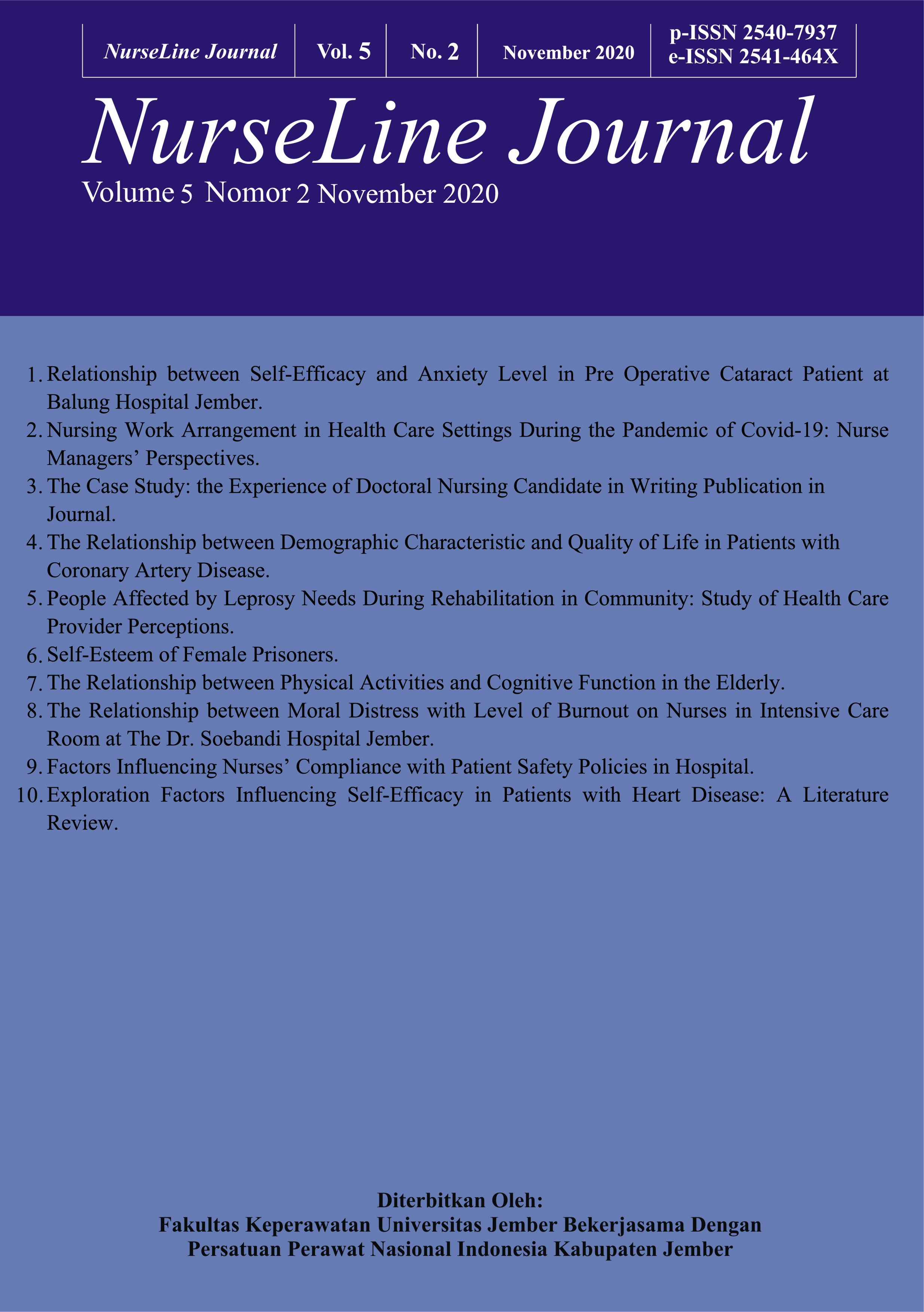Relationship between Self-Efficacy and Anxiety Level in Pre Operative Cataract Patient at Balung Hospital Jember
DOI:
https://doi.org/10.19184/nlj.v5i2.16387Keywords:
self efficacy, level of anxiety, pre operative cataractAbstract
Cataract causes lowering visibility and becomes the main risk factor of blindness that can be healed by performing surgery. The surgery may cause anxiety which is affected by self efficacy. Thus, the self efficacy boost the human’s confidence in making decision, reducing stress, as well as lowering the depression risk.
The objective of this research is to analyze the correlation between self efficacy and the level of anxiety to the pre-cataract operation patients at Balug Regional Hospital.
This research comprises 2 variables there are self-efficacy (independent variables) and the level of anxiety (dependent variable) that is observed using descriptive analytical method by using purposive sampling. The data collection method used in this research is perfomed by using Pre Operative Self Efficacy Scale (PSES) to assess self efficacy and The Amsterdam Preoperative Anxiety and Information Scale (APAIS) to determine the level of anxiety. The analysis of the correlation between self efficacy and the level of anxiety is conducted by using The Spearman Rank Correlation (p=0,05).
The result of this research reveals the median score of the self efficacy is 146,00 with the average of 131,48. The percentage of self efficacy reveals as many as 53 respondents (84,1%) show good self efficacy as opposed to 10 respondents (15,9%) who show poor self efficacy. The percentage of the repondents’ level of anxiety reveals as many as 39 respondents (61,9%) show mild level of anxiety. The result of this research also reveals the correlation between self efficacy and the level of anxiety of the pre-cataract operation patients (p = 0,001 r = -0,691) with negative direction. This means that the higher self efficacy, the lower level of anxiety is.
Conclusion: Self efficacy plays important roles in controlling anxiety. Any individuals with high confidence may control what happens, thus allowing low level of anxiety to appear, respectively.
Downloads
References
Astuti, P. 2011. Pengaruh Edukasi Preoperasi Terstruktur (dengan Teori Kognitif Sosial Terhadap Self Efficacy dan Perilaku Latihan Post Operasi pada Pasien Fraktur Ekstermitas Bawah dengan Pembedahan di Surabaya. Tesis. Depok : Fakultas Ilmu Keperawatan Universitas Indonesia
Bandura, A. 2007. Self Efficacy Conception on Ophtamology. Anxiety Research: International Journal. 1(2):77-98
Bedaso, A., dan M. Anyalew. 2019. Preoperative Anxiety among Adults Patients Undergoing Elective Surgery: a Prospective Survey at a General Hospital in Ethiopia. Patient Safety in Surgery. 13 (18):2-8. https://www.ncbi.nlm.nih.gov/pmc/articles/PMC6454677/pdf/13037_2019_Article_198.pdf [Diakses pada tanggal 30 September 2019]
Chen, H.L., K. Liu., dan Q.S. You. 2017. Effect of Couple based Coping Intervention on Self Efficacy and Quality of Life in Patient with Lung Cancer Surgery. Patient Education and Counseling. 100 (12):2297-3302
Depkes. 2018. Jumlah Penderita Katarak di Indonesia Tinggi, Menkes Ingatkan Perilaku Hidup Sehat. http://www.depkes.go.id/article/view/18110500001/jumlah-penderita-katarak-di-indonesia-tinggi-menkes-ingatkan-perilaku-hidup-sehat.html [diakses pada 30 Agustus 2019 pukul 00.53]
Ekinci, M., B. Emre, dan O. Dulgero. 2017. The Relationship Between Preoperative Anxiety Levels and Vasovagal Incidents During The Administration of Spinal Anesthesia. 67(4):388–394.
Firdaus, M. 2014. Uji Validitas Konstruksi dan Reiliabilitas Instrumen The Amsterdam Preopretavive Anxiety and Information Scale (APAIS) Versi Indonesia.Tesis. Jakarta: Fakultas Kedokteran Universitas Indonesia
Havivah. 2019. Gambaran Tingkat Kecemasan Pasien Pre-Operasi Katarak di Kabupaten Jember. Skripsi. Jember : Fakultas Keperawatan Universitas Jember
Hutauruk, J., dan S. Siregar. 2017. Katarak : 101 Jawaban atas Pertanyaan Anda. Jakarta: EGC
Infodantin. 2014. Situasi Gangguan Penglihatan dan Kebutaan. Jakarta: Kemenkes
Klein, B., R. Klein, dan M. Knudtson. 2005. Intraocular Pressure and Systemic Blod Pressure: Longitudinal Perspective: The Beaver Dan Eye Study. Journal Ophthalmol. Vol 89 : 285-287
National Eye Institute. 2014. New Research Sheds Light in How UV Rays May Contribute to Cataract. https://www.nei.nih.gov/about/news-and-events/news/new-research-sheds-light-how-uv-rays-may-contribute-cataract
Parnanda, D. 2017. Perbedaan Tekanan Intra Okular (TIO) Sebelum dan Sesudah Operasi Fakoemulsifikasi pada Pasien Katarak Senilis di RSUP Fatmawati Tahun 2016. Skripsi. Fakultas Kedokteran dan Ilmu Kesehatan Universitas Islam Negeri Syarif Hidayatullah Jakarta
Pender, N. 2011. Health Promotion Model Manual. https://deepblue.lib.umich.edu/bitstream/handle/2027.42/85350/HEALTH_PROMOTION_MANUAL_Rev_5-2011.pdf [diakses pada 10 Januari 2019]
Prahara S., K. Budiyani. 2018. Pelatihan Efikasi Diri untuk Meningkatkan Efikasi Diri Terhadap Kemampuan Berwirausaha Anak Down Syndrom pada Orangtua. Insight. 20 (1) :1-14
Ramirez, D., F. Brodie, J. Nussbaumer, dan S. Ramanathan. 2017. Anxiety in patients undergoing cataract surgery: a pre- and postoperative comparison. Pubmed. 11:1979–1986
Sari, A., Masriadi, dan Arman. 2018. Faktor Risiko Kejadian Katarak pada Pasien Pria Usia 40-55 Tahun di Rumah Sakit Pertamina Balikpapan. Jurnal Kesehatan. 1(2):61–67.
Tahmassian, K., dan N. J. Moghadam. 2011. Relathionship Between Self Efficacy and Symptoms of Anxiety, Depression, Worry and Social Avoidance in a Normal Sample of Students. 5(2):91-98
Zetterberg, M. 2014. Gender and Cataract-The Role of Esterogen. Jpurnal Current Eye Research.
Zhang, X. 2003. Sex Hormones and Their Receptors in Patient With Age Related Cataract. NCBI. 29(1) 71-77








